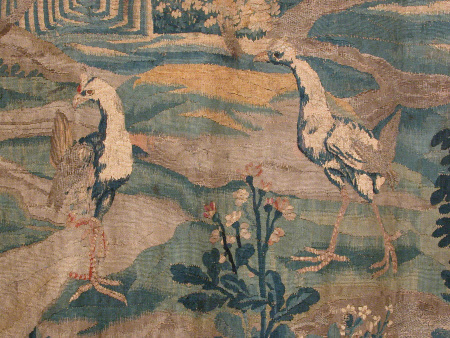Verdure with two Chickens
probably Oudenaarde
Category
Tapestries
Date
1670 - 1710
Materials
Tapestry, wool and silk, 5 warps per cm
Measurements
1920 x 2250 mm
Order this imageCollection
Packwood House, Warwickshire
NT 557883
Summary
Tapestry, wool and silk, 5 warps per cm, Verdure with two chickens, probably Oudenaarde, c.1670-1710. A wooded landscape with a leafy bank on the left hand side, plants growing in the foreground, and two long-necked chickens standing in the centre beside a path which winds through the landscape. In the background to the left of the centre is an avenue of trees leading to a vanishing point, and to the right of this a second path leads through the landscape into the distance. There is more foliage along the top and the right hand edge of the tapestry. There are borders on all four sides with a repeating design of scrolls, leaves and fleurs-de-lys, and a further narrow band with an egg-and-dart pattern on the outer edge. The border is now faded to greyish tones but may originally have been more colourful, as small areas have retained a deep red tonality.
Full description
The design of this tapestry with its leafy landscape broken by a winding pathway, its tree-lined avenue in the distance, and the two birds in the foreground, is typical of verdure tapestries woven in a number of different weaving centres in the Netherlands from the mid seventeenth to the mid eighteenth century. High quality examples include a verdure with a river running through a wooded landscape and two wading birds in the foreground made by the Brussels weaver Daniel Abbeloos in the 1670s (Standen 1985, vol. 1, cat. no. 33, pp. 218-219). Although similar in conception the example at Packwood is far coarser in design and execution, and was probably woven at Oudenaarde, a city which produced large numbers of middle to low quality tapestries for the export market. Similar examples made in Oudenaarde include a verdure with two cranes in the Bowes Museum (inv. Founders/tap.27), and a set of four commissioned for the Bishop’s Palace at Liège in 1752 and still in situ (De Meûter 1999, p. 248). Similar two-tone borders recalling carved picture frames are found on a number of Oudenaarde tapestries from the late seventeenth century. The tapestry appears to have been cut down at some point in the past, and although the left hand border is integral to the central field, the other three borders have been removed and re-attached. This tapestry is almost certainly the “Gobelins Tapestry” which Baron Ash bought in Tournai in 1918, a few days after the end of the First World War. He records the event in his wartime diary, in the entry for 18 November 1918: “I spent most of the morning trying to buy a superb piece of Gobelins tapestry & all the afternoon wondering under the circs [circumstances] how I am going to finance it. Still I try to look upon it as a spec [speculation] but don’t quite know how far I am right in doing so.” (Helen Wyld, 2009)
Provenance
Bought by Graham Baron Ash in Tournai in 1918, and given by him to the National Trust in 1941
Credit line
Packwood House, The Graham Baron Ash Collection (The National Trust)
Makers and roles
probably Oudenaarde, workshop
References
Standen, 1985: Edith Appleton Standen, European post-medieval tapestries and related hangings in the Metropolitan Museum of Art, New York 1985 , vol. 1, cat. no. 33, pp. 218-219 De Meûter, 1998: Ingrid de Meûter, ‘Flemish Tapestries of the 16th and 17th Centuries in Great Britain and their Connection with Oudenaarde’, Bulletin de liaison du Centre International d’Étude des Textiles Anciens [CIETA], 75 (1998), pp. 97-109 de Meûter et al., 1999: Ingrid de Meûter, Martine Vanwelden et al., Tapisseries d'Audenarde du XVle au XVllle Siècle, Tielt 1999, p. 248

